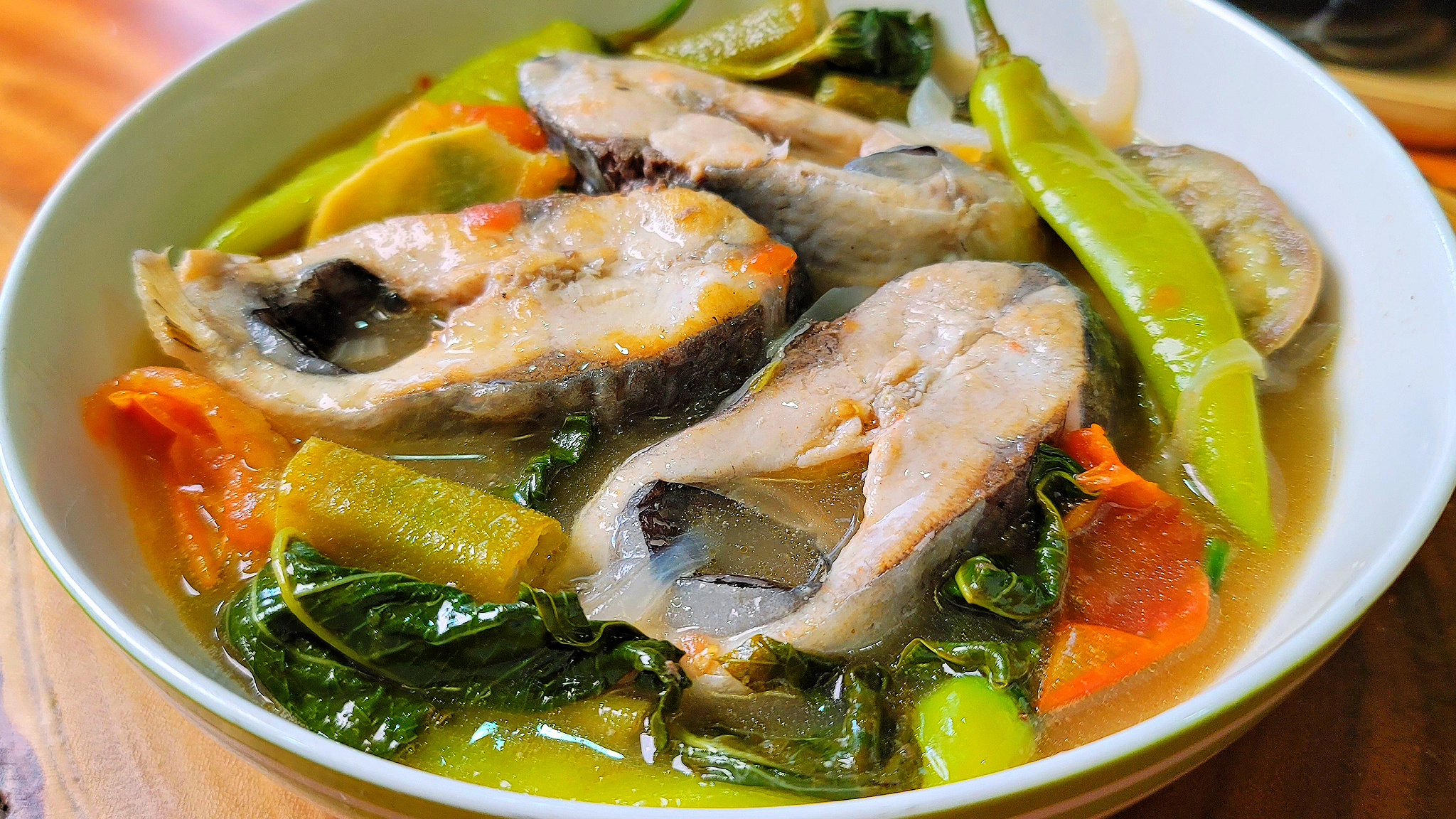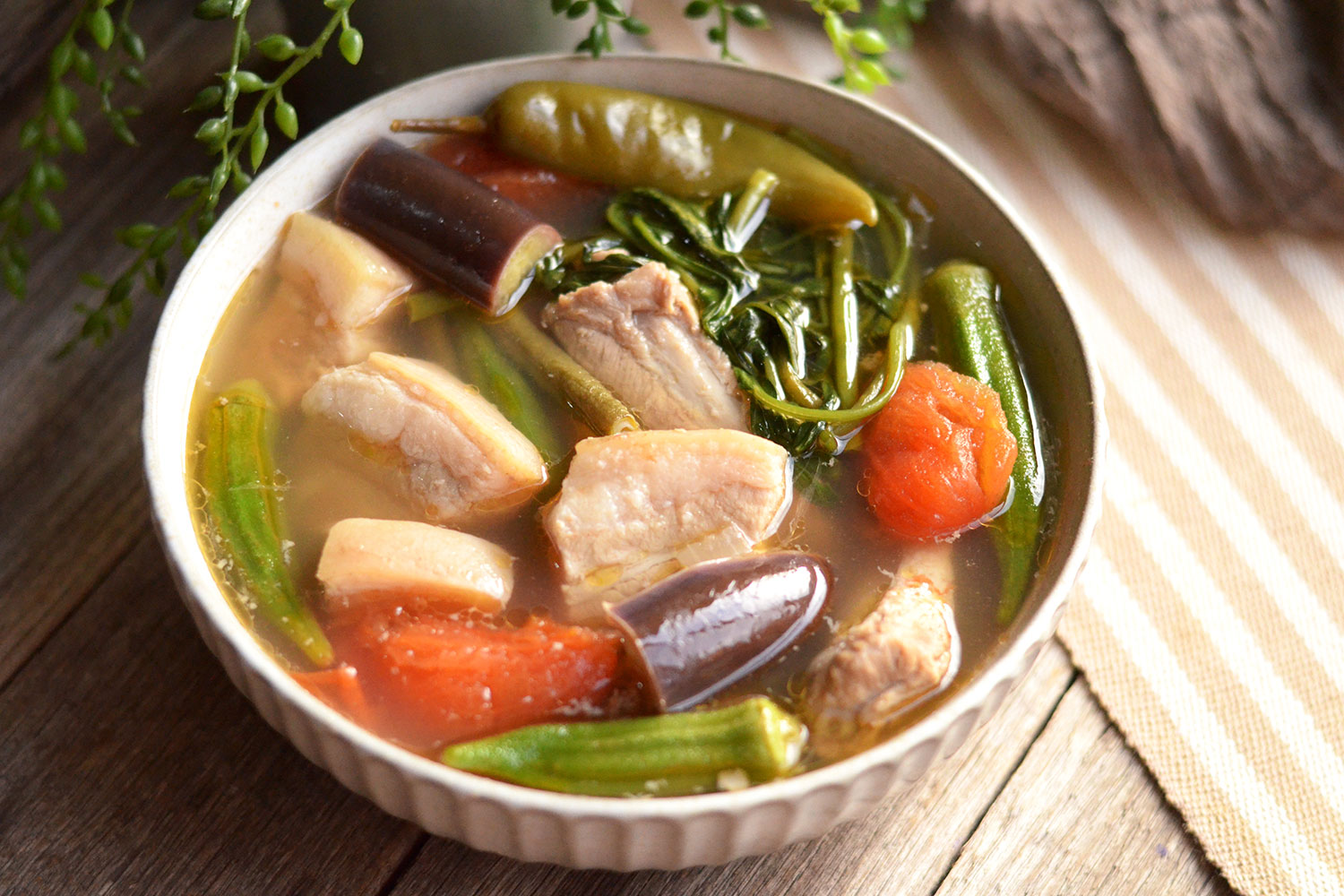There's something truly special about a warm bowl of sinigang, isn't there? It’s a soup that just feels like home, like a comforting hug on a chilly day, or even a refreshing pick-me-up when it's warm outside. For many, the distinctive sour taste of sinigang is the very essence of Filipino cooking, a flavor that brings back so many good memories. This time, we are putting a spotlight on a wonderful seafood version, the delicious sinigang na pampano, which is a bit of a favorite for a lot of people.
Sinigang, you see, is a traditional Filipino soup that is famous for its bright, tangy flavor. This particular taste comes mostly from tamarind, though other souring agents can be used. It's a dish that really shows off the heart of Filipino home cooking, offering a soothing and flavorful experience that many people crave. It’s the kind of meal that makes you want to sit down and just savor every spoonful, perhaps with a plate of steamed rice.
When you hear "sinigang," perhaps your mind goes to pork or beef, but fish sinigang, especially with pampano, offers a lighter yet equally satisfying option. This particular fish, pampano, brings a delicate sweetness to the sour broth, making for a truly delightful combination. We’ll go through how to make this wonderful dish, sharing some cooking approaches and tips so you can make it just right, perhaps even better than you thought possible.
Table of Contents
- What Makes Sinigang na Pampano Special?
- The Heart of Sinigang: The Souring Agent
- Essential Ingredients for Your Pampano Sinigang
- The Cooking Approach: Boil or Sauté?
- Step-by-Step Recipe for Sinigang na Pampano
- Tips for a Perfectly Sour Soup
- Frequently Asked Questions About Sinigang
- Why Sinigang is a Timeless Favorite
What Makes Sinigang na Pampano Special?
Pampano, sometimes called pompano, is a type of fish that’s really quite good for soups. It has a mild flavor and a soft texture that holds up well when cooked in a broth. When you combine this with the signature sourness of sinigang, you get a dish that is both light and deeply flavorful. It’s a choice that many people prefer for fish sinigang because it doesn’t have a strong "fishy" taste, which can be a concern for some. This means the pampano lets the sour broth really shine, which is pretty important for this kind of soup.
The beauty of sinigang na pampano, you know, is how it balances the tartness of the soup base with the gentle taste of the fish. It’s a comforting meal, often enjoyed with family. The warmth of the soup, especially when it's a bit cool outside, feels incredibly soothing. It's a dish that, in some respects, truly embodies comfort food for many Filipinos, and it's easy to see why it remains so popular.
The Heart of Sinigang: The Souring Agent
The defining characteristic of sinigang is its sourness. Traditionally, this comes from fresh tamarind. People often boil fresh tamarind pods until they are soft, then mash them to extract the sour pulp, which is then strained into the soup. This old-school way, you know, really gives the soup a depth of flavor that is quite unique. It’s a process that takes a little bit of time, but many say it's worth the effort for the truly authentic taste.
However, in today's busy kitchens, many cooks use instant sinigang mixes. Brands like Knorr are very popular, offering a quick and convenient way to get that familiar sour taste without the fuss. It's actually quite common to make sinigang with these mixes. Even the sinigang soup from places like Mang Inasal, which many people really enjoy, seems to be made with sinigang powder, and it's still incredibly tasty, so there’s that.
Essential Ingredients for Your Pampano Sinigang
Beyond the pampano fish and the souring agent, a good sinigang relies on a specific set of vegetables that add flavor, texture, and nutrition. These vegetables, you know, are pretty much non-negotiable for a truly authentic sinigang. They soak up the sour broth and contribute their own subtle tastes to the overall dish.
Here are the common vegetables you'll want to have on hand:
- Okra: These pods get wonderfully tender and release a slight thickening agent into the soup, which is actually quite nice.
- Kangkong (Water Spinach/Ong Choy/Morning Glory): Its leafy greens wilt perfectly in the hot broth, adding a fresh, slightly bitter note.
- Onion: Often sliced into wedges, onions provide a foundational sweetness and aroma to the soup base.
- Tomato: Quartered tomatoes add a touch of color and a subtle fruity acidity that complements the tamarind. Ideally, you put the onion and the tomato in early on.
- Gabi (Taro): These starchy root vegetables become soft and creamy, helping to thicken the soup a bit and add a pleasant texture.
- Radish (Labanos/Daikon): Sliced radish adds a crisp, peppery bite that is really quite refreshing against the sourness.
- Green Chilis (Siling Haba): These are usually added whole to provide a mild heat, but you can break them open if you want more spice, which some people really like.
Having these ingredients ready, you know, makes the cooking process so much smoother. Each one plays a part in creating that balanced, comforting flavor profile that sinigang is known for.
The Cooking Approach: Boil or Sauté?
One interesting question that comes up when making sinigang is whether you start by sautéing your ingredients or simply letting everything boil from the beginning. This is a topic that some people have strong feelings about, actually. It really depends on what kind of sinigang you're making and what kind of flavor you're hoping to achieve.
The Boil-First Method
For many traditional sinigang recipes, especially those with pork or beef, the approach is often to just let it boil. My way, for instance, is to let the water come to a boil first, and then throw in the ingredients. This method is straightforward and allows the flavors to meld together as everything cooks in the simmering broth. It’s a simpler way, in some respects, to get that classic sinigang taste without too much fuss. You just add the meat or fish, then the hardier vegetables, and finally the softer ones.
When you are making sinigang na pampano, this boil-first method works really well. The delicate fish doesn't need much pre-cooking. You simply add it to the simmering sour broth, and it cooks through gently, absorbing all the wonderful flavors. This keeps the fish from breaking apart too much, which is quite important for presentation and texture, you know.
The Sautéing Approach for Sinigang sa Miso
Now, there's a variant of sinigang called sinigang sa miso, and in this version, you do typically sauté the garlic and onions first. This adds a layer of aromatic flavor before the broth is added. Sinigang sa miso often has a yellow miso taste, which gives the soup a different kind of richness and depth. For this type of fish sinigang, the fish itself might be fried ahead of time or just boiled directly into the soup, depending on your preference. So, it's a bit of a different preparation, but still very much sinigang at its heart.
The difference in starting with a sauté versus just boiling, you know, can subtly change the overall taste profile. Sautéing can bring out more sweetness from the onions and a deeper aroma from the garlic. For sinigang na pampano, while the boil-first method is common, if you wanted to add a touch of richness or were making a miso version, then a quick sauté would be the way to go, apparently.
Step-by-Step Recipe for Sinigang na Pampano
Let’s get down to making this comforting soup. This recipe will focus on the boil-first method, which is pretty common for fish sinigang, especially with an instant mix for ease. You'll learn how to cook it with an instant mix, which is quite convenient for busy days, too.
Ingredients:
- 1 medium pampano fish, cleaned and sliced into serving pieces
- 1 packet (22g) sinigang mix (tamarind soup base)
- 6-8 cups water (or more, depending on desired soup amount)
- 1 medium onion, quartered
- 2 medium tomatoes, quartered
- 1 small radish (labanos/daikon), sliced into rounds
- 1 cup gabi (taro), peeled and cubed
- 1 cup kangkong (water spinach), trimmed
- 6-8 pcs okra, trimmed
- 2-3 pcs green chilis (siling haba), whole
- Fish sauce (patis) to taste
- Salt and pepper to taste
Instructions:
- Prepare the Broth Base: In a large pot, pour in the water. Bring it to a rolling boil. Once it's boiling, add the quartered onion and tomatoes. Let these simmer for about 5-7 minutes, or until the onions become tender. This step helps to build a good foundation of flavor for your soup, which is really quite important.
- Add the Souring Agent: Stir in the sinigang mix. Make sure it dissolves completely. Taste the broth to check the sourness. If you prefer it more sour, you can add a little more mix, or if you are using fresh tamarind, you would add your extracted tamarind juice here. This is where the magic happens, so to speak.
- Introduce Hardier Vegetables: Next, add the gabi (taro) and radish slices to the pot. Let them cook for about 8-10 minutes, or until they are nearly tender. Gabi takes a bit longer to cook through, so adding it early ensures it will be perfectly soft when the soup is ready, which is what you want.
- Add the Pampano Fish: Gently place the pampano fish pieces into the simmering broth. Cook for about 5-7 minutes, or until the fish is opaque and cooked through. Be careful not to overcook the fish, as it can become tough or fall apart, which is not ideal, you know.
- Incorporate Softer Vegetables: Finally, add the okra, kangkong, and whole green chilis. Cook for another 2-3 minutes, or until the vegetables are just tender-crisp. You want them to still have a bit of bite, so don't let them get too soft, apparently.
- Season and Serve: Season the sinigang with fish sauce, salt, and pepper to your liking. Taste and adjust as needed. Some people really like a good amount of fish sauce, which adds a lot of umami. Serve hot with steamed rice. It’s a meal that is best enjoyed right away, so.
Tips for a Perfectly Sour Soup
Getting the sourness just right is key to a great sinigang. Here are a few pointers that might help you achieve that perfect balance. You want it to be tangy, but not overwhelmingly so, which can be a bit tricky for some.
- Taste as You Go: This is probably the most important tip. Start with the recommended amount of sinigang mix or tamarind, then add more gradually until you reach your preferred level of sourness. Everyone has a slightly different preference, you know.
- Fresh Tamarind vs. Mix: While mixes are convenient, using fresh tamarind pods can give a more nuanced, natural sourness. If you want to go the old school way, ask the store if they have fresh tamarind. It really does make a difference for some people.
- Consider Miso: For a different take, try sinigang sa miso. This version, as mentioned, involves sautéing garlic and onions and adding yellow miso, which gives it a unique savory depth along with the sourness. It's a very interesting variation, actually.
- Don't Overcook the Fish: Pampano cooks quickly. Overcooking will make it dry and flaky, and it might break apart in the soup, which you definitely want to avoid. Keep an eye on it, so.
- Vegetable Timing: Add vegetables in stages, from hardier ones like gabi and radish first, to softer ones like kangkong and okra last. This ensures everything cooks perfectly without becoming mushy, which is pretty important for texture.
- The Broth is King: For many, the best part of sinigang is the broth. As someone mentioned, "Mas masarap pa rin yung may nahihigop kang sabaw" (It's still better when you have broth to sip). So, make sure your broth is well-seasoned and has that delightful sour kick. This is true whether it's sinigang na baboy at buto buto or a fish version, too.
Frequently Asked Questions About Sinigang
People often have questions about sinigang, given its many forms and cooking methods. Here are some common queries that come up, which might help you understand this wonderful soup even better.
What is the main souring agent in sinigang?
The primary souring agent for sinigang is usually tamarind. It can be in the form of fresh tamarind pods, which are boiled and mashed to extract the sour pulp, or as a convenient instant sinigang mix powder. Both give that signature tangy taste, though some people find the fresh tamarind provides a more complex sourness, apparently.
Can I use other types of fish for sinigang?
Yes, you absolutely can use other types of fish for sinigang! While pampano is a great choice for its mild flavor and firm texture, other popular options include salmon, maya-maya (red snapper), or even bangus (milkfish). The key is to choose a fish that holds up well in soup and complements the sour broth, so.
Is it common to make sinigang with an instant mix?
It is very common to make sinigang with an instant mix, actually. Many Filipino households, including mine, use brands like Knorr for convenience. While some prefer the traditional method using fresh tamarind, the mixes provide a consistent and quick way to enjoy this beloved soup, which is pretty handy for busy cooks. It's how many people were taught to make it, too.
Why Sinigang is a Timeless Favorite
Sinigang, whether it's made with pork, beef, or delicate pampano fish, holds a special place in Filipino cuisine. It’s a dish that truly embodies the comforting essence of Filipino home cooking. It’s adaptable, flavorful, and just feels good to eat, especially on a cool evening, or even when it's hot, you know, because it's just that good.
The joy of sinigang, and specifically sinigang na pampano, comes from its ability to bring people together around a table. It's a simple dish, but its flavors are deep and satisfying. If you've never tried making it, now is a good time to give it a go. There's nothing quite like a steaming bowl of this sour soup to warm you up from the inside out, and it's quite easy to customize to your own taste, too. Learn more about Filipino cuisine on our site, and perhaps try this recipe, which is a wonderful way to enjoy a classic. You can also find more delicious Filipino recipes by visiting this page here for more ideas. For other great Filipino food ideas, you might want to check out a reputable source like this food blog for inspiration.



Detail Author:
- Name : Mr. Diego Cassin Sr.
- Username : gleason.clifton
- Email : hackett.isabel@gmail.com
- Birthdate : 1975-10-05
- Address : 84097 Waelchi Summit Suite 678 Destinhaven, AK 30085-9813
- Phone : +14587172433
- Company : Little-Adams
- Job : Radar Technician
- Bio : Illo tempora omnis est nihil. Dolorem ipsam quae odit culpa itaque. Nihil dolor aliquid nemo rerum nihil dolores rerum.
Socials
instagram:
- url : https://instagram.com/zmoore
- username : zmoore
- bio : Impedit recusandae totam provident minima. Aut vitae ut et sequi. Debitis qui hic odit in est.
- followers : 160
- following : 2502
linkedin:
- url : https://linkedin.com/in/zella.moore
- username : zella.moore
- bio : Omnis et et ipsum vel vel et deleniti similique.
- followers : 736
- following : 2553



























